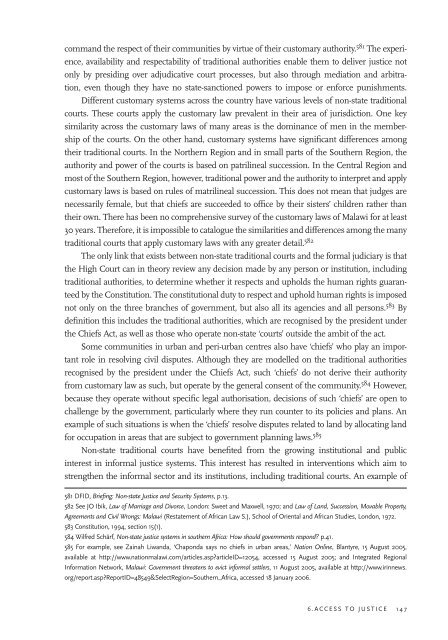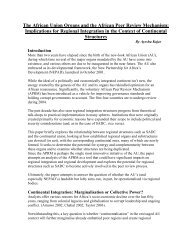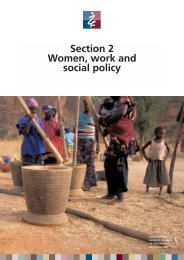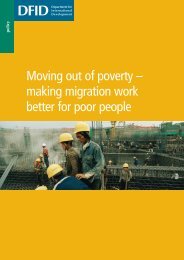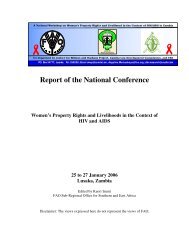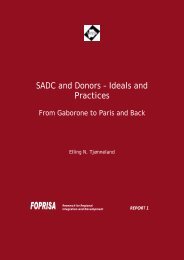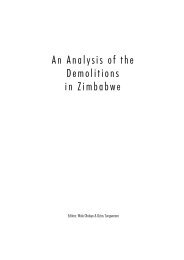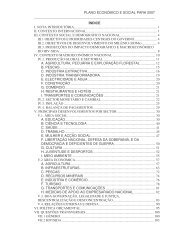Justice Sector and the Rule of Law - AfriMAP
Justice Sector and the Rule of Law - AfriMAP
Justice Sector and the Rule of Law - AfriMAP
You also want an ePaper? Increase the reach of your titles
YUMPU automatically turns print PDFs into web optimized ePapers that Google loves.
comm<strong>and</strong> <strong>the</strong> respect <strong>of</strong> <strong>the</strong>ir communities by virtue <strong>of</strong> <strong>the</strong>ir customary authority. 581 The experience,availability <strong>and</strong> respectability <strong>of</strong> traditional authorities enable <strong>the</strong>m to deliver justice notonly by presiding over adjudicative court processes, but also through mediation <strong>and</strong> arbitration,even though <strong>the</strong>y have no state-sanctioned powers to impose or enforce punishments.Different customary systems across <strong>the</strong> country have various levels <strong>of</strong> non-state traditionalcourts. These courts apply <strong>the</strong> customary law prevalent in <strong>the</strong>ir area <strong>of</strong> jurisdiction. One keysimilarity across <strong>the</strong> customary laws <strong>of</strong> many areas is <strong>the</strong> dominance <strong>of</strong> men in <strong>the</strong> membership<strong>of</strong> <strong>the</strong> courts. On <strong>the</strong> o<strong>the</strong>r h<strong>and</strong>, customary systems have significant differences among<strong>the</strong>ir traditional courts. In <strong>the</strong> Nor<strong>the</strong>rn Region <strong>and</strong> in small parts <strong>of</strong> <strong>the</strong> Sou<strong>the</strong>rn Region, <strong>the</strong>authority <strong>and</strong> power <strong>of</strong> <strong>the</strong> courts is based on patrilineal succession. In <strong>the</strong> Central Region <strong>and</strong>most <strong>of</strong> <strong>the</strong> Sou<strong>the</strong>rn Region, however, traditional power <strong>and</strong> <strong>the</strong> authority to interpret <strong>and</strong> applycustomary laws is based on rules <strong>of</strong> matrilineal succession. This does not mean that judges arenecessarily female, but that chiefs are succeeded to <strong>of</strong>fice by <strong>the</strong>ir sisters’ children ra<strong>the</strong>r than<strong>the</strong>ir own. There has been no comprehensive survey <strong>of</strong> <strong>the</strong> customary laws <strong>of</strong> Malawi for at least30 years. Therefore, it is impossible to catalogue <strong>the</strong> similarities <strong>and</strong> differences among <strong>the</strong> manytraditional courts that apply customary laws with any greater detail. 582The only link that exists between non-state traditional courts <strong>and</strong> <strong>the</strong> formal judiciary is that<strong>the</strong> High Court can in <strong>the</strong>ory review any decision made by any person or institution, includingtraditional authorities, to determine whe<strong>the</strong>r it respects <strong>and</strong> upholds <strong>the</strong> human rights guaranteedby <strong>the</strong> Constitution. The constitutional duty to respect <strong>and</strong> uphold human rights is imposednot only on <strong>the</strong> three branches <strong>of</strong> government, but also all its agencies <strong>and</strong> all persons. 583 Bydefinition this includes <strong>the</strong> traditional authorities, which are recognised by <strong>the</strong> president under<strong>the</strong> Chiefs Act, as well as those who operate non-state ‘courts’ outside <strong>the</strong> ambit <strong>of</strong> <strong>the</strong> act.Some communities in urban <strong>and</strong> peri-urban centres also have ‘chiefs’ who play an importantrole in resolving civil disputes. Although <strong>the</strong>y are modelled on <strong>the</strong> traditional authoritiesrecognised by <strong>the</strong> president under <strong>the</strong> Chiefs Act, such ‘chiefs’ do not derive <strong>the</strong>ir authorityfrom customary law as such, but operate by <strong>the</strong> general consent <strong>of</strong> <strong>the</strong> community. 584 However,because <strong>the</strong>y operate without specific legal authorisation, decisions <strong>of</strong> such ‘chiefs’ are open tochallenge by <strong>the</strong> government, particularly where <strong>the</strong>y run counter to its policies <strong>and</strong> plans. Anexample <strong>of</strong> such situations is when <strong>the</strong> ‘chiefs’ resolve disputes related to l<strong>and</strong> by allocating l<strong>and</strong>for occupation in areas that are subject to government planning laws. 585Non-state traditional courts have benefited from <strong>the</strong> growing institutional <strong>and</strong> publicinterest in informal justice systems. This interest has resulted in interventions which aim tostreng<strong>the</strong>n <strong>the</strong> informal sector <strong>and</strong> its institutions, including traditional courts. An example <strong>of</strong>


